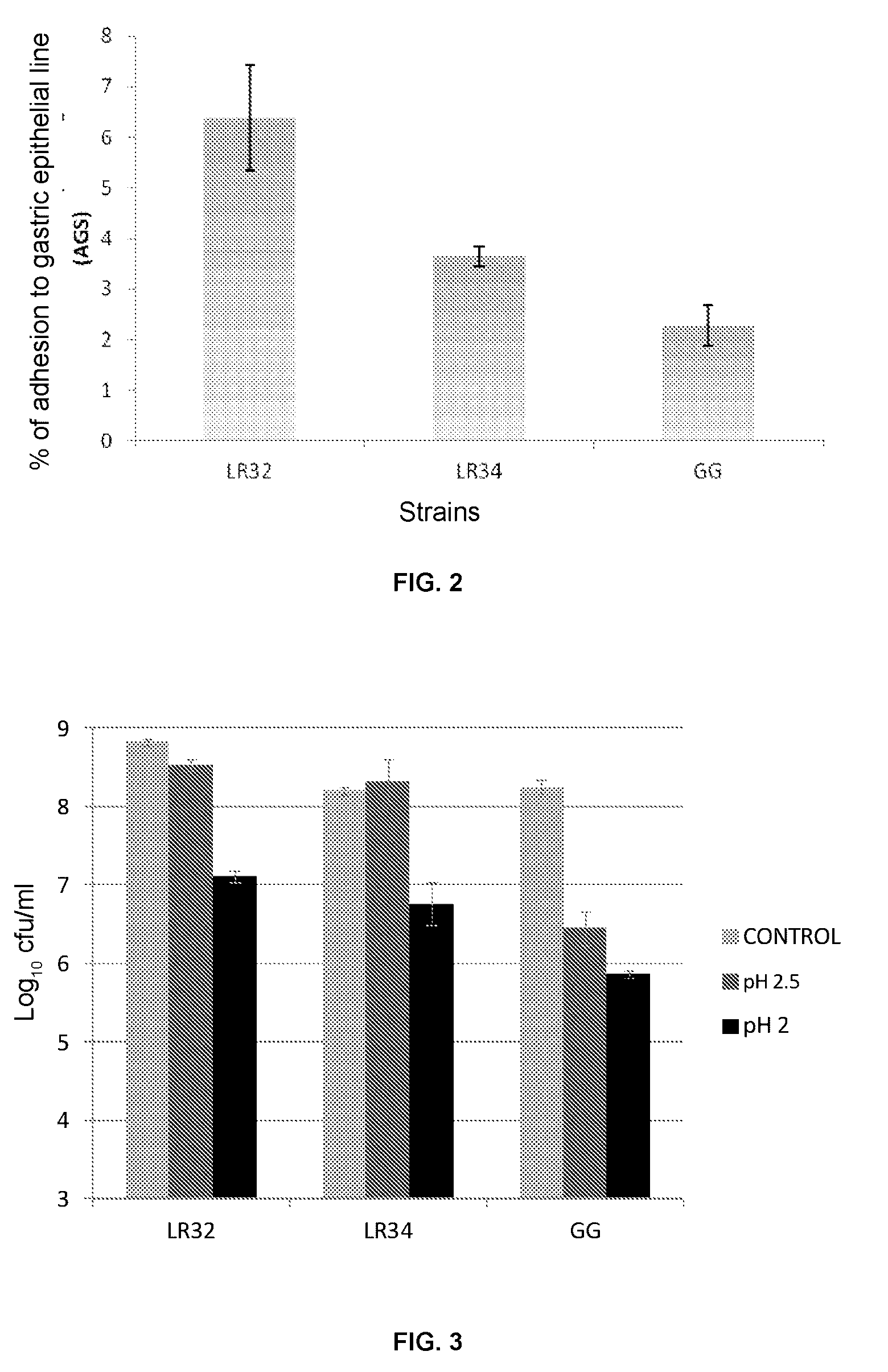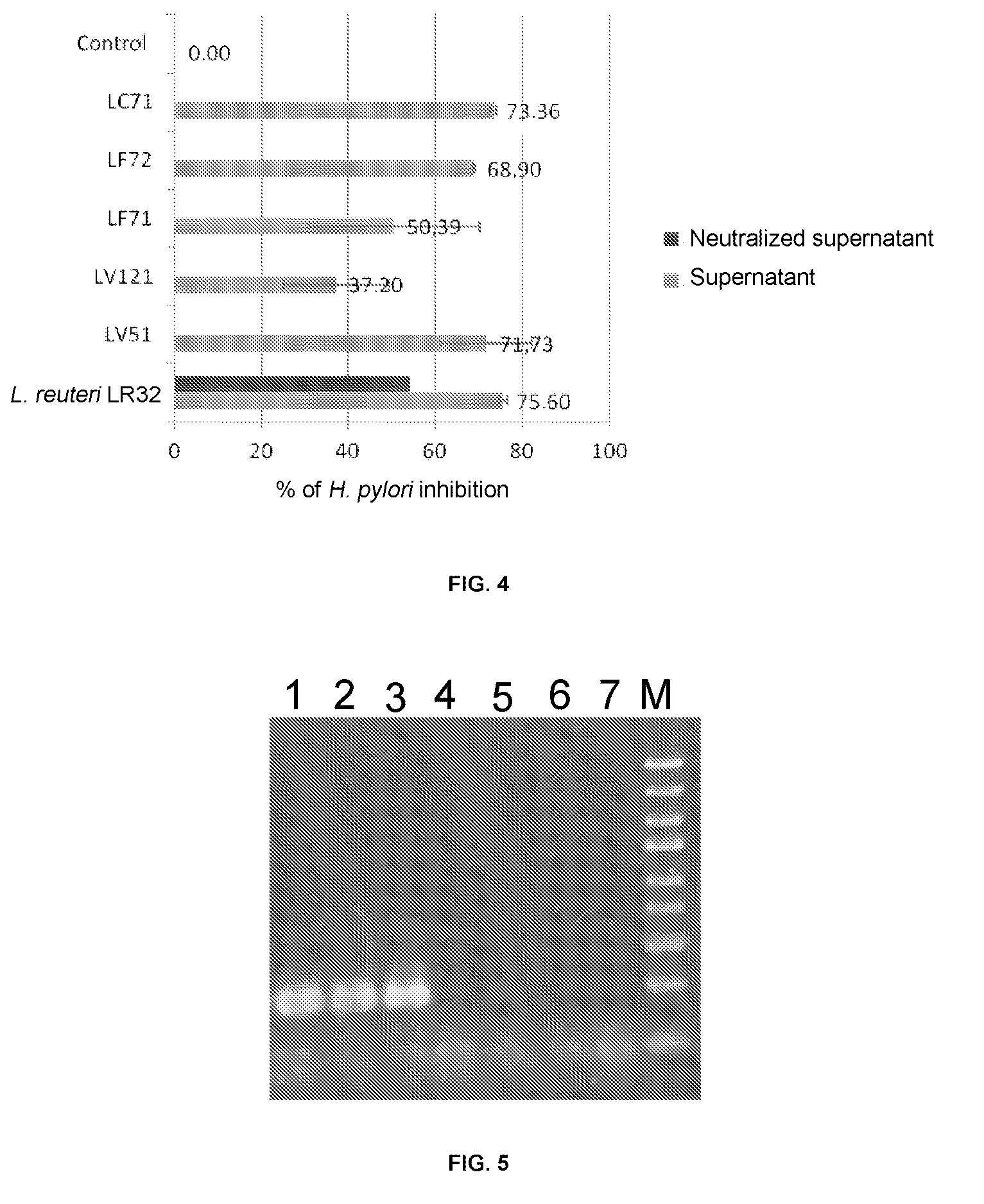Probiotic Strain of Lactobacillus Reuteri Exhibiting Anti-Helicobacter Activity, a Probiotic or Biotherapeutic Product Comprising Said Strain, and the Use Thereof
- Summary
- Abstract
- Description
- Claims
- Application Information
AI Technical Summary
Benefits of technology
Problems solved by technology
Method used
Image
Examples
example 1
Isolation of the Strain of Lactobacillus reuteri LR32 from the Human Stomach
[0081]The strain of L. reuteri LR32 was isolated from a mucosal sample of the stomach of a healthy subject taken during a routine gastric endoscopy (Delgado et al., 2013; Microb. Ecol. 65:763-72). After biopsy, the mucosal sample was delivered to the laboratory in a sterile reducing solution made up of 0.9% NaCl, 0.1% peptone, 0.1% Tween 80® and 0.02% cysteine, being analyzed within two hours following extraction. The sample was washed in phosphate buffered saline (PBS) and homogenized and broken up in a maximum recovering diluent (Scharlab). This suspension (100 μl) was seeded in duplicate on the surface of MRSC (“de Man, Rogosa and Sharpe” medium with 0.25% cysteine) culture plates. The strain LR32 was recovered from these plates after 72 hours of incubation in an anaerobic chamber (Mac500, Down Whitley Scientific) with anaerobic atmosphere (10% H2, 10% CO2, 80% N2). The strain was reseeded to depletion in...
example 2
Capacity of the Strain of L. reuteri LR32 and of other Strains used as Reference to Adhere to the Gastric Epithelium
[0082]The experimental procedure consisted of co-incubating the epithelial line AGS in confluent phase with the strain L. reuteri LR32 obtained according to Example 1. Additionally, the epithelial line was co-incubated with another gastric strain of L. reuteri (LR34) and with the commercial probiotic strain Lactobacillus rhamnosus GG (considered an adherent strain standard). A concentration of 105 cfu / ml of each bacterial strain and a bacteria:cells ratio of 1:1 were used. The adhesion assays were performed in wells in duplicate and the experiment was repeated three times. After one hour of joint incubation at 37° C., bacteria that did not adhere to the epithelial monolayer were eliminated with three successive washes with PBS. The adhered bacteria were detached by breaking the monolayer with a 0.25% trypsin-EDTA solution and counted by means of ten-fold serial dilutio...
example 3
Resistance of the Strain of L. reuteri LR32 Isolated from the Human Stomach and of other Strains used as Reference to the Conditions of the Gastrointestinal Tract
[0083]To see the resistance capacity of the strain L. reuteri LR32 isolated from the human stomach and of other strains that were used as reference, the strains were subjected to conditions of extreme acidity and to the presence of intestinal bile salts to simulate conditions similar to those of the upper part of the gastrointestinal tract.
3.1. Capacity to Grow in Acidic Conditions
[0084]The strain L. reuteri LR32 of the invention and another gastric strain of L. reuteri (LR34) were subjected to a preliminary assay to determine their capacity to initiate growth at pH 2.5. To that end, based on the active 24-hour cultures of the strains “Microtiter” plates filled with 200 μl MRSC medium acidified with 12N hydrochloric acid (HCl) at pH 2.5 were inoculated by 2%. The plates were incubated in anaerobic chamber and after 48 hours...
PUM
| Property | Measurement | Unit |
|---|---|---|
| temperature | aaaaa | aaaaa |
| pH | aaaaa | aaaaa |
| pH | aaaaa | aaaaa |
Abstract
Description
Claims
Application Information
 Login to View More
Login to View More - R&D
- Intellectual Property
- Life Sciences
- Materials
- Tech Scout
- Unparalleled Data Quality
- Higher Quality Content
- 60% Fewer Hallucinations
Browse by: Latest US Patents, China's latest patents, Technical Efficacy Thesaurus, Application Domain, Technology Topic, Popular Technical Reports.
© 2025 PatSnap. All rights reserved.Legal|Privacy policy|Modern Slavery Act Transparency Statement|Sitemap|About US| Contact US: help@patsnap.com



